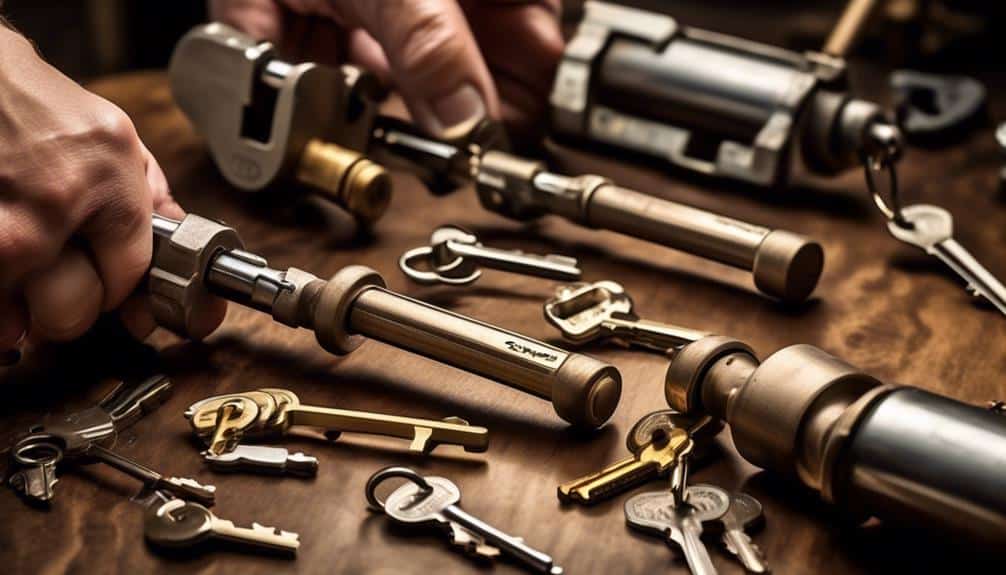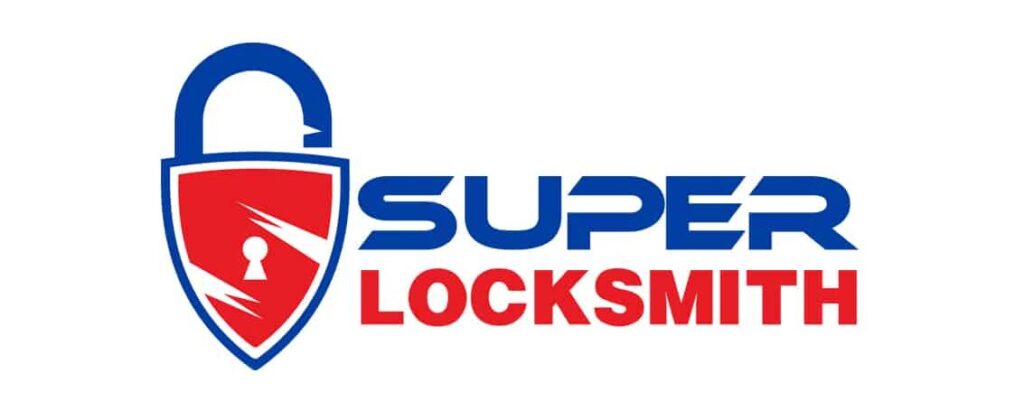Have you ever wondered about the intricate process behind creating a duplicate key for a lever handle lock?
Picture yourself standing in front of a door, holding a key that seems to hold all the secrets within it.
As professional locksmiths, we have mastered the art of unlocking these secrets and replicating keys with precision. But how exactly do we do it?
In this discussion, we will unveil the hidden techniques and tools used to duplicate lever handle lock keys, leaving you with a newfound appreciation for the skill and expertise required in this fascinating field of locksmithing.
So, let's journey together into the world of lever handle lock key duplication, where every detail matters and every lock has its own story to tell.
The Basics of Key Duplication
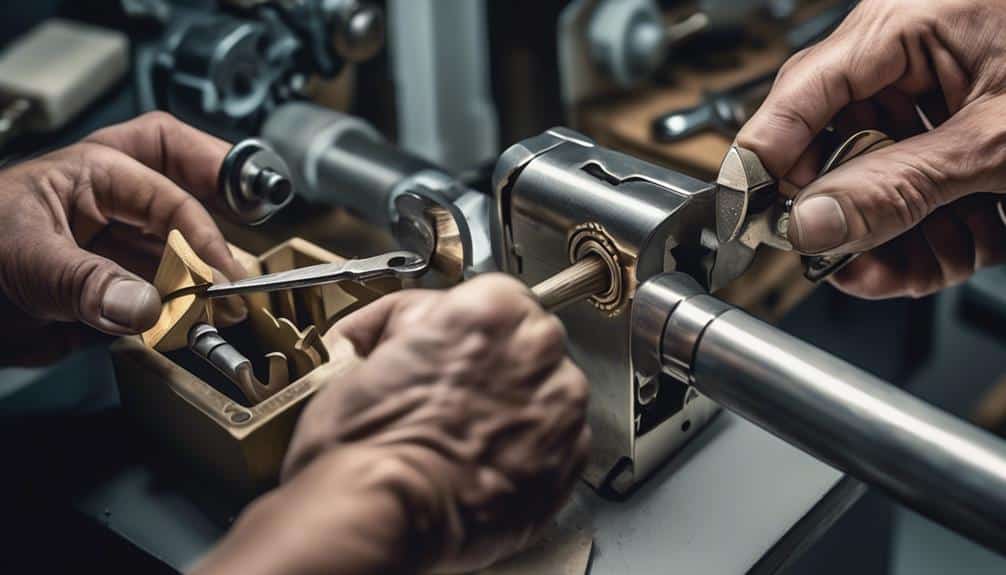
Key duplication is a common practice in which a duplicate key is made from an existing key, allowing users to have multiple copies for various purposes. Understanding the basics of key duplication is essential for locksmiths, security professionals, and even homeowners.
One of the primary benefits of key duplication is convenience. Having multiple copies of a key ensures that individuals can easily access their properties without the need for complex lock picking techniques. Additionally, key duplication provides a sense of security as it allows for quick and easy access in case of emergencies.
To duplicate a key, the process involves creating an exact replica of the original key. This can be achieved using various methods such as manual key cutting or using automated key duplication machines. The key duplication process requires precision and expertise to ensure that the duplicate key fits and functions properly in the lock.
However, it's important to note that key duplication should only be done by authorized individuals or professionals. Unauthorized duplication of keys can pose security risks and compromise the safety of the property.
Understanding Lever Handle Locks
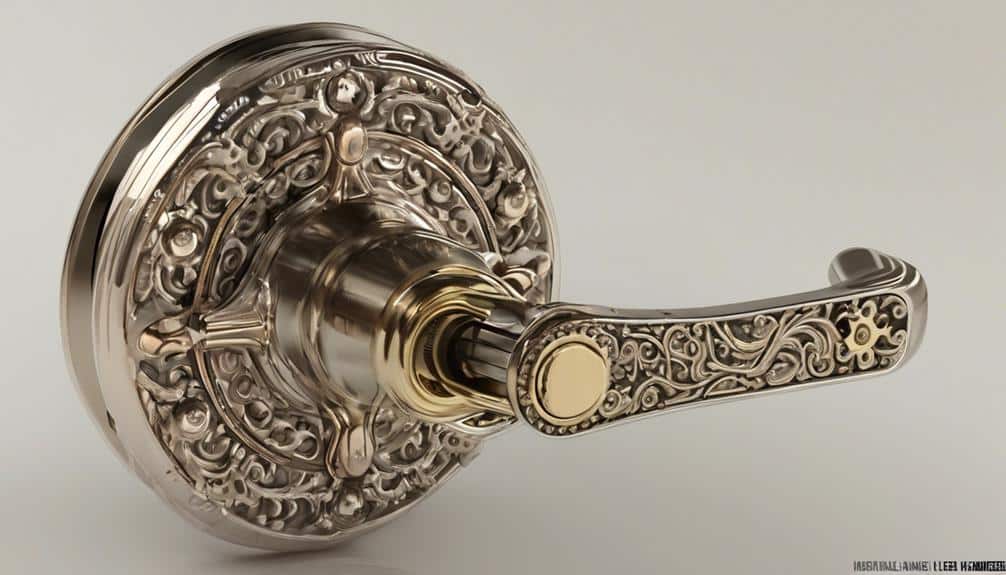
Having a solid understanding of lever handle locks is crucial for locksmiths, security professionals, and homeowners alike, as it further enhances their knowledge of key duplication and ensures the proper functioning of duplicate keys. Lever handle locks are commonly found in residential and commercial settings, providing a secure means of access control. These locks operate using a set of levers that must be lifted to specific heights in order to align the inner mechanism and allow the lock to be turned.
To better understand lever handle locks, let's examine the types of lever handle mechanisms commonly used:
| Mechanism | Description |
|---|---|
| Simple Lever | Consists of a single lever that must be lifted to a specific height |
| Double Lever | Features two levers that work in tandem, requiring precise alignment to unlock |
| Paracentric Lever | Utilizes a unique keyway design with angled levers to enhance security and prevent picking |
| Detainer Lever | Contains additional set of levers, known as detainers, which further complicate the unlocking process |
| Disc-detainer Lever | Combines the detainer mechanism with rotating discs for added security |
While lever handle locks offer robust security, they are not without their common issues. Some of these issues include worn levers, misalignment of the levers, and keyway blockages. Additionally, lever handle locks may be susceptible to picking or bumping if not properly maintained. Understanding these common issues allows locksmiths and homeowners to identify and address potential problems before they compromise the security of the lock.
Different Types of Key Blanks
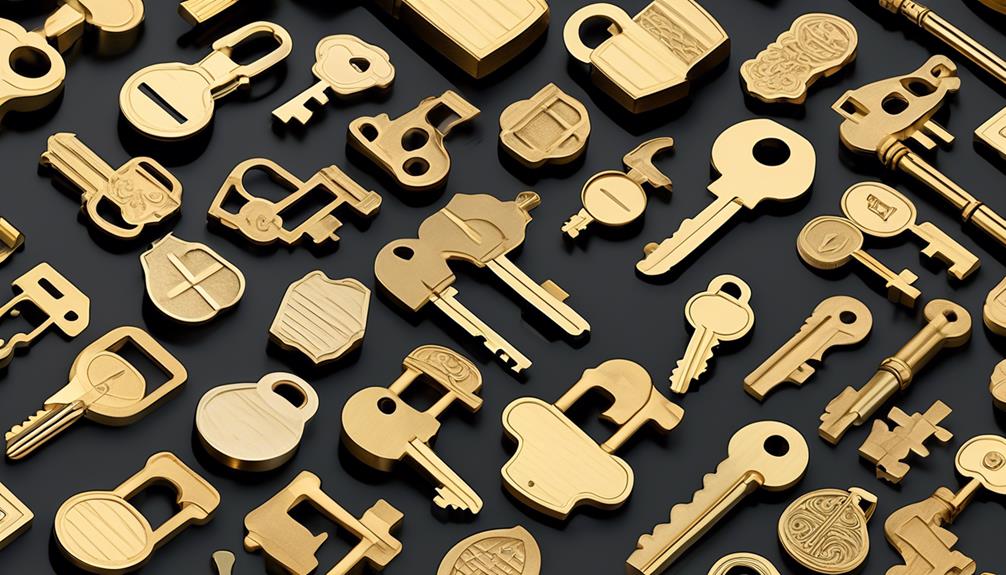
When it comes to key duplication, it's important to understand the different types of key blanks available. Key blank varieties can vary based on their shape, size, and the type of lock they're designed to fit.
It's crucial to ensure key blank compatibility with the specific lock you're duplicating, as using an incompatible key blank can result in a faulty duplicate.
Key Blank Varieties
With various types of key blanks available, it's important to understand the different varieties to ensure a successful duplication process for lever handle locks. Key blank varieties can vary in terms of their manufacturing process and material options. Here are some key points to consider:
- Manufacturing Process: Key blanks are typically manufactured through either casting or stamping processes. Casting involves pouring molten metal into a mold to create the desired shape, while stamping involves cutting the shape out of a sheet of metal.
- Material Options: Key blanks can be made from various materials, including brass, steel, and aluminum. Brass is often preferred for its durability and corrosion resistance, while steel offers strength and security. Aluminum key blanks, on the other hand, are lightweight and easy to handle.
- Shapes and Sizes: Key blanks come in different shapes and sizes to accommodate various lever handle lock designs. It's important to choose the right blank that matches the specific lock you're duplicating.
- Keyway Types: Key blanks also differ in terms of their keyway types, which determine how the key is inserted into the lock. Common keyway types include standard, high-security, and restricted keyways.
- Compatibility: Finally, it's crucial to ensure that the key blank is compatible with the key cutting machine you're using for duplication. Different machines may require specific types of key blanks to operate efficiently.
Key Blank Compatibility
To ensure a successful duplication process for lever handle locks, it's crucial to understand the compatibility of different types of key blanks.
Key blank compatibility refers to the ability of a key blank to be accurately duplicated using specific key duplication methods. Different key blank manufacturers produce key blanks that may vary in size, shape, and design. This variation can affect the compatibility between the original key and the key blank used for duplication.
It's important to choose a key blank that's compatible with the lever handle lock being duplicated to ensure an accurate copy of the original key. Key blank compatibility can be determined by consulting the manufacturer's specifications or seeking advice from a professional locksmith.
Key Blank Duplicates
Different types of key blanks play a crucial role in the key duplication process for lever handle locks. Key blank duplicates are essential in ensuring that the duplicated key fits perfectly into the lock mechanism. There are various types of key blank materials available, each with its own unique characteristics. These materials include brass, steel, nickel-silver, and aluminum.
Key blank cutting is another important aspect of key duplication. Precision is key when cutting the key blank, as even the slightest deviation can render the duplicate key useless. The cutting process involves using specialized key cutting machines that accurately replicate the grooves and notches of the original key onto the blank.
To summarize, understanding the different types of key blank materials and utilizing precise key blank cutting techniques are vital in creating successful duplicates for lever handle locks.
Tools Needed for Key Duplication
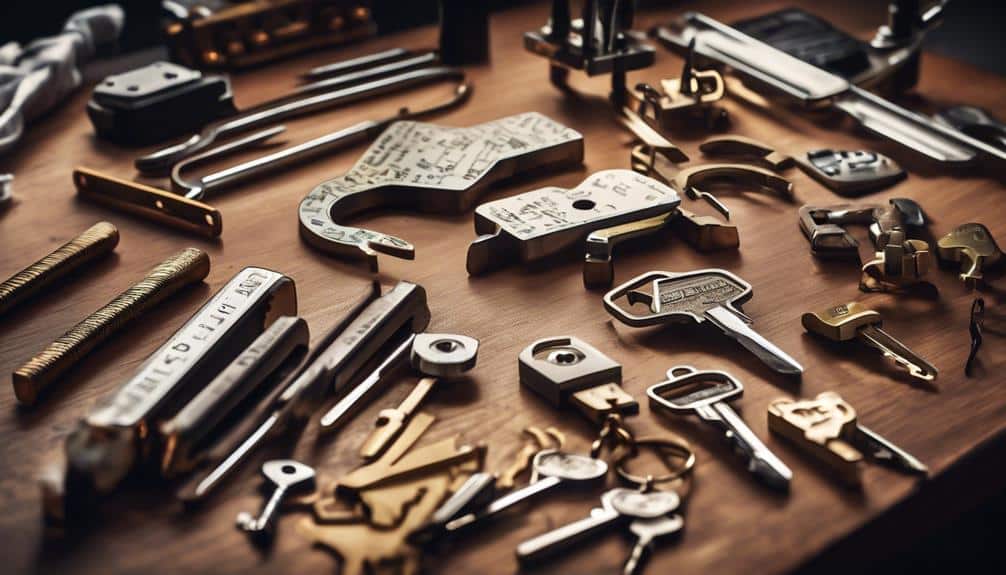
For key duplication, a set of specialized tools is required to ensure precise and efficient results. When it comes to key duplication techniques, especially for vintage lever handle locks, it's crucial to have the right tools at hand.
One of the essential tools is the key cutting machine. This machine is designed to accurately cut a duplicate key by following the grooves and depths of the original key. It's equipped with adjustable jaws and a cutting blade that can be fine-tuned to match the specific lock's requirements.
Another important tool is the key gauge or key decoder. This tool helps locksmiths determine the correct key blank to use for duplication. By inserting the original key into the gauge, locksmiths can identify the correct key blank by comparing the positions of the notches and grooves.
Locksmiths also rely on key duplicators or key cloners. These devices allow for the duplication of keys without the need for a physical key. Instead, they use technology to scan and store the key's information, which can then be used to create an accurate duplicate.
Step-by-Step Guide to Key Duplication
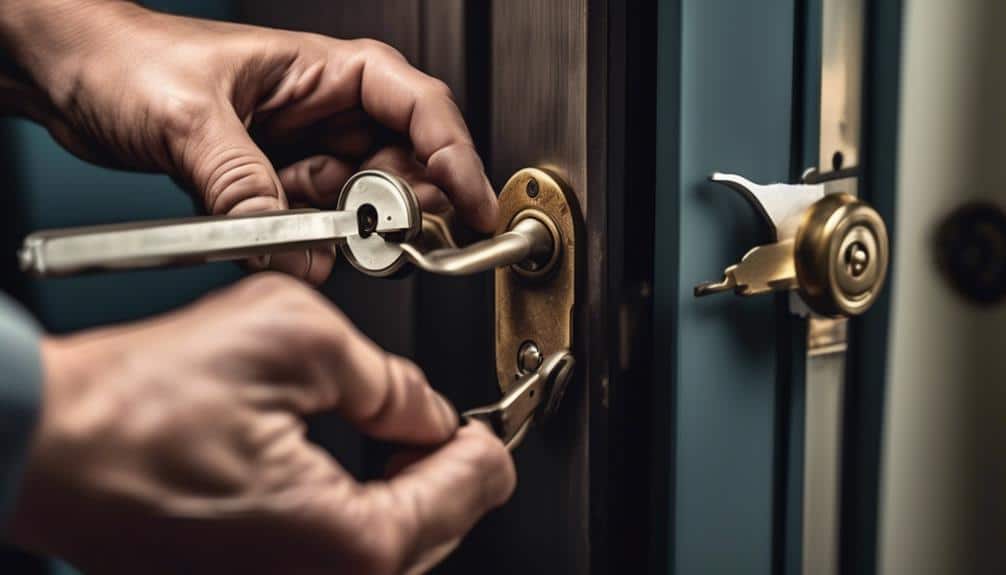
Now let's move on to the step-by-step guide for key duplication.
In this section, we'll discuss the different types of lever handles.
Next, we'll cover the key duplication process itself.
Finally, we'll provide some useful tips for ensuring a successful duplication.
Types of Lever Handles
To accurately duplicate a lever handle key, it's essential to understand the various types of lever handles and their corresponding key designs. Lever handle locks are commonly used in both residential and commercial settings due to their durability and ease of use.
Here are five types of lever handles commonly found in lever handle lock installations:
- Passage lever handles: These lever handles are used in areas where locking isn't required, such as hallways or closets.
- Privacy lever handles: Designed for bedrooms or bathrooms, these lever handles have a locking mechanism that can be engaged from the inside.
- Entry lever handles: These lever handles are used on exterior doors and feature a keyhole for secure locking.
- Classroom lever handles: Typically used in educational institutions, these lever handles allow for locking from the inside but require a key to unlock from the outside.
- Storeroom lever handles: These lever handles are always locked from the outside and require a key to gain entry.
Understanding the different types of lever handles is crucial for accurate key duplication and ensuring the security of lever handle lock installations.
Key Duplication Process
To accurately duplicate a lever handle key, one must follow a step-by-step guide that ensures precise and technical execution. Key duplication for electronic lever handle locks and smart lever handle locks requires specific tools and knowledge of the lock's unique characteristics. Here is a simplified guide to the key duplication process:
- Gather the necessary tools: A key duplicating machine, original key, and blank key.
- Identify the type of lever handle lock and its keyway profile.
- Place the original key into the machine's clamp and secure it.
- Insert the blank key into the machine's cutting wheel.
- Adjust the machine's settings according to the keyway profile.
- Activate the machine to cut the blank key, following the original key's pattern.
- Test the duplicated key in the lock to ensure functionality and accuracy.
Following this step-by-step process will result in a successfully duplicated lever handle key for electronic and smart locks.
Tips for Successful Duplication
For successful duplication of a lever handle key, it's crucial to follow a precise and technical step-by-step guide. Key duplication can sometimes be a tricky process, but by following these best practices, you can increase your chances of a successful duplication:
- Use high-quality blank keys: Ensure that you're using blank keys of the same brand and model as the original key to ensure compatibility.
- Clean the original key: Before duplicating, clean the original key to remove any dirt or debris that may affect the accuracy of the duplication process.
- Calibrate the key cutting machine: Regularly calibrate the key cutting machine to ensure accurate and precise cuts.
- Check for key duplication troubleshooting guide: If you encounter any issues during the duplication process, consult a key duplication troubleshooting guide for assistance.
- Test the duplicated key: After duplication, test the new key in the lock to ensure it functions properly.
Common Mistakes to Avoid in Key Duplication
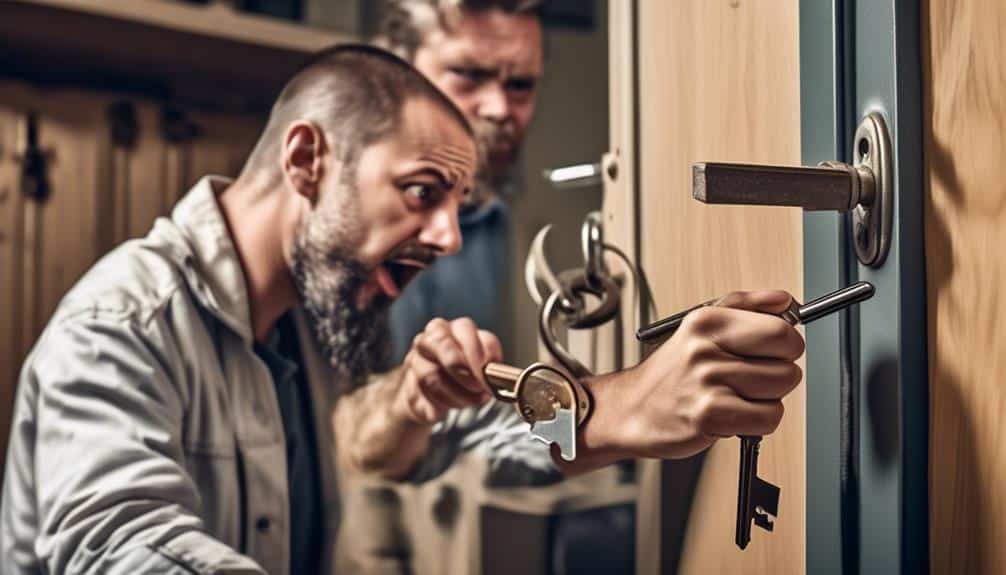
A key duplication process can be prone to errors, which should be avoided to ensure accurate and functional results. To help you avoid these mistakes and achieve successful key duplication, we have compiled a list of common errors and tips to overcome them.
| Common Mistakes | Tips for Successful Duplication |
|---|---|
| Incorrect key type | Always use the correct key type for duplication. Using the wrong key can result in an inaccurate copy. Check the key type carefully before proceeding. |
| Poor key alignment | Ensure proper alignment of the original key and the blank key during duplication. Misalignment can lead to an ineffective copy that may not work properly in the lock. |
| Low-quality key blank | Choose high-quality key blanks for duplication. Low-quality blanks may not be durable and can wear out quickly, causing the duplicated key to become ineffective. |
Key Duplication for Residential Lever Handle Locks
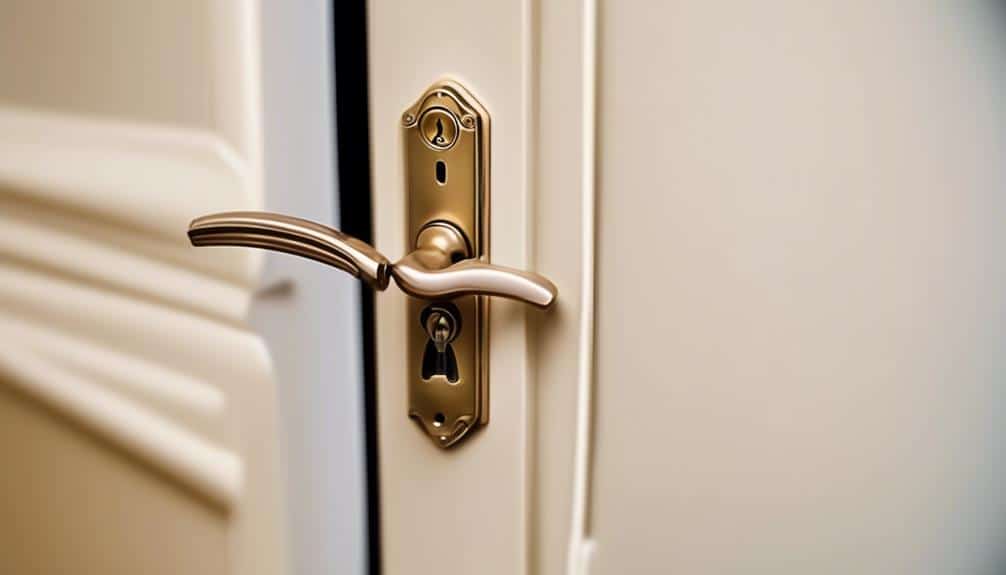
Let's now turn our attention to the key duplication process for residential lever handle locks.
One important factor to consider is the compatibility of the lever handle lock with the key duplication machine. Different lock manufacturers may have their own unique key profiles, so it's crucial to ensure that the key duplication machine supports the specific type of lever handle lock you have.
Understanding this compatibility aspect will greatly assist in achieving accurate and effective key duplication results.
Lever Handle Lock Compatibility
The compatibility of lever handle locks for key duplication in residential settings is an essential factor to consider. When it comes to lever handle lock installation and troubleshooting, understanding compatibility can save time and money. Here are five key points to consider:
- Different lever handle locks may have different keyways, which means not all keys will fit all locks.
- Some lever handle locks are designed for specific brands or models, so it's important to choose a compatible key blank.
- Lever handle locks may have different security features, such as anti-pick mechanisms or restricted key systems, which can affect key duplication.
- It's crucial to ensure that the key blank matches the lock's keyway profile, length, and thickness.
- Consulting with a professional locksmith can help determine the compatibility of lever handle locks and ensure successful key duplication.
Understanding the compatibility of lever handle locks is crucial for efficient key duplication in residential settings. By considering these points, homeowners can avoid unnecessary frustration and ensure that their lever handle locks are functioning optimally.
Key Duplication Process
To duplicate keys for residential lever handle locks, the key duplication process involves precise steps and careful consideration of the lock's specifications.
When it comes to key duplication for electronic and smart lever handle locks, additional factors need to be taken into account. These advanced locks often come with unique security features that require specialized equipment and expertise for key duplication.
For electronic lever handle locks, the process typically involves programming a new key to match the lock's electronic system. This requires access to the lock's programming interface and the use of specialized software.
Similarly, key duplication for smart lever handle locks involves pairing a new key with the lock's smart technology, which may require the use of a smartphone app or other device.
It's essential to consult the lock manufacturer's guidelines and seek the assistance of a professional locksmith experienced in duplicating keys for these types of locks to ensure a successful duplication process.
Key Duplication for Commercial Lever Handle Locks
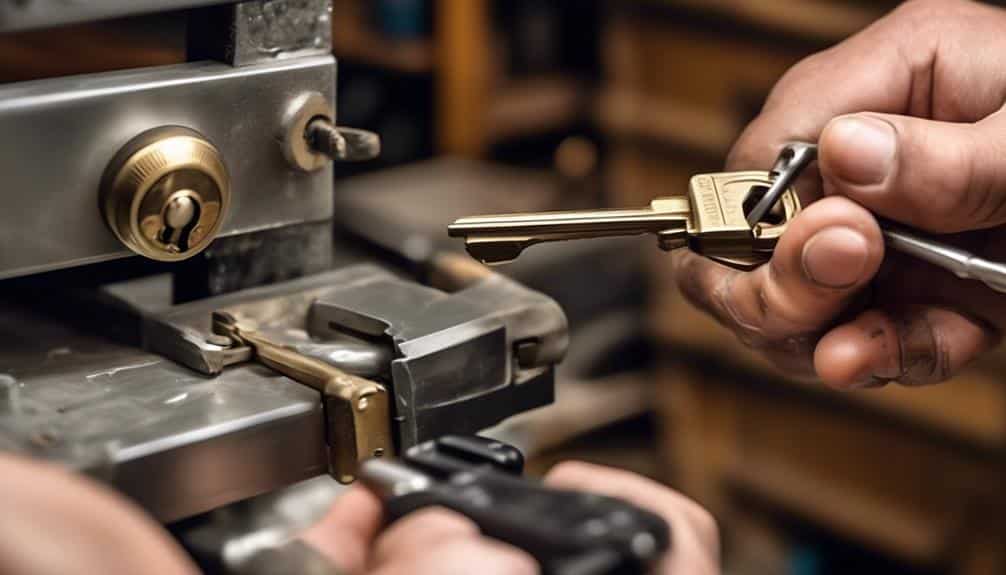
When duplicating keys for commercial lever handle locks, it's important to follow precise and technical procedures to ensure accuracy and security. Lever handle lock key duplication poses unique challenges due to the complex mechanisms involved. To overcome these challenges, advanced techniques have been developed to ensure the duplication process is efficient and effective.
Here are some key considerations when duplicating keys for commercial lever handle locks:
- Key profiling: Each lever handle lock requires a specific key profile, which determines the size and shape of the key. It's crucial to accurately replicate the key profile to ensure compatibility with the lock.
- Key cutting machines: Utilizing high-quality key cutting machines equipped with advanced software is essential for precise duplication. These machines use laser or milling technology to accurately cut the key to the required specifications.
- Key blank selection: Choosing the correct key blank is crucial to ensure a perfect duplication. Key blanks come in various sizes and shapes, and selecting the appropriate one is vital to ensure a secure fit.
- Key duplication accuracy: Precision is paramount when duplicating keys for commercial lever handle locks. Even slight variations in key cutting can result in key failure or compromised security.
- Security measures: To maintain the integrity of key duplication, strict security measures should be in place. This includes verifying the identity of the person requesting the duplication and keeping detailed records of all key duplications.
Key Duplication for Automotive Lever Handle Locks
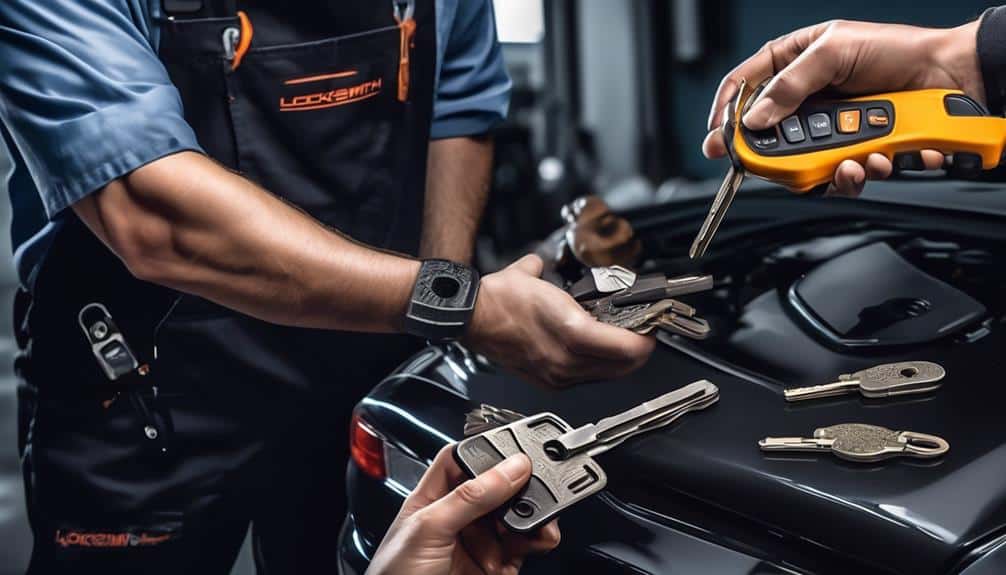
When it comes to key duplication for automotive lever handle locks, there are specific techniques and challenges that need to be addressed.
We understand the importance of precise and accurate key duplication for these locks, as they play a crucial role in vehicle security.
In this discussion, we'll explore the key duplication techniques, common challenges, and the solutions for automotive lever handle locks.
Automotive Lever Handle Locks
One effective method for duplicating keys for automotive lever handle locks is to use specialized key cutting machines. These machines are designed to accurately replicate the grooves and notches of the original key, ensuring a precise fit and smooth operation.
Here are five important points to consider when it comes to automotive lever handle locks:
- Automotive lever handle lock installation requires a thorough understanding of the locking mechanism and the vehicle's specific requirements.
- Troubleshooting automotive lever handle locks involves identifying common issues such as jamming, misalignment, or worn-out components.
- Regular maintenance is crucial to keep the lock functioning optimally. This includes lubricating moving parts and inspecting for any signs of wear or damage.
- It's essential to choose high-quality materials for automotive lever handle locks to ensure durability and resistance to tampering or forced entry.
- Proper key management is important to prevent unauthorized duplication and ensure the security of the vehicle.
Key Duplication Techniques
To duplicate keys for automotive lever handle locks, a specialized key cutting machine is typically used to accurately replicate the grooves and notches of the original key, ensuring a precise fit and smooth operation. Key duplication methods have evolved significantly with advancements in key duplication technology.
These machines use precise measurements and cutting techniques to create an exact replica of the original key. The key cutting machine scans the original key and creates a digital profile, which is then used to cut a new key with the same grooves and notches. This process allows for a high level of accuracy and eliminates the need for manual measurements or guesswork.
With key duplication technology, locksmiths and automotive professionals can quickly and accurately create duplicate keys for lever handle locks, ensuring the security and convenience of their customers.
Common Challenges and Solutions
A common challenge in key duplication for automotive lever handle locks is ensuring the accurate replication of the intricate grooves and notches found in the original key. To address this challenge, technicians can employ a variety of solutions:
- Utilizing advanced key cutting machines equipped with high precision laser technology for precise replication.
- Taking precise measurements of the original key's grooves and notches and using them as a guide for duplication.
- Inspecting the original key under a microscope to identify any hidden details that may affect the accuracy of the duplicate.
- Testing the duplicate key in the lever handle lock to ensure smooth operation and proper alignment.
- Seeking assistance from experienced locksmiths or manufacturers who specialize in lever handle lock installation and troubleshooting.
Key Duplication for High-Security Lever Handle Locks
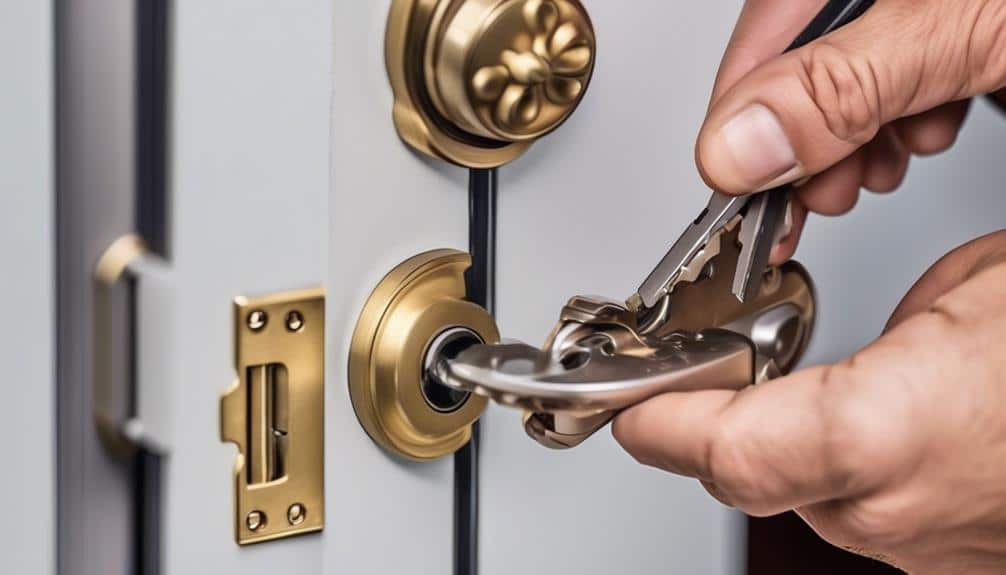
Key duplication for high-security lever handle locks involves specialized techniques and equipment to ensure precision and accuracy. When it comes to key duplication for lever handle locks with electronic access control, the process becomes even more intricate. These locks have advanced features such as proximity sensors, encrypted communication protocols, and complex key codes.
To duplicate a key for such a lock, we need to use specialized equipment that can read and replicate the unique electronic signature embedded in the original key. This requires knowledge of the specific lock manufacturer's protocols and encryption methods.
Similarly, key duplication for lever handle locks with biometric authentication presents its own set of challenges. These locks use fingerprint or iris scanning technology to grant access. Duplicating a key for such a lock requires capturing and replicating the biometric data stored in the original key. This involves using advanced imaging and data processing techniques to create an accurate duplicate.
In both cases, the key duplication process for high-security lever handle locks requires a high level of expertise and precision. It's crucial to use the correct equipment and follow specific protocols to ensure that the duplicate key functions seamlessly with the lock's advanced security features.
Therefore, it's advisable to rely on professional locksmith services with experience in key duplication for high-security lever handle locks to ensure the utmost security and accuracy.
Key Duplication for Vintage Lever Handle Locks
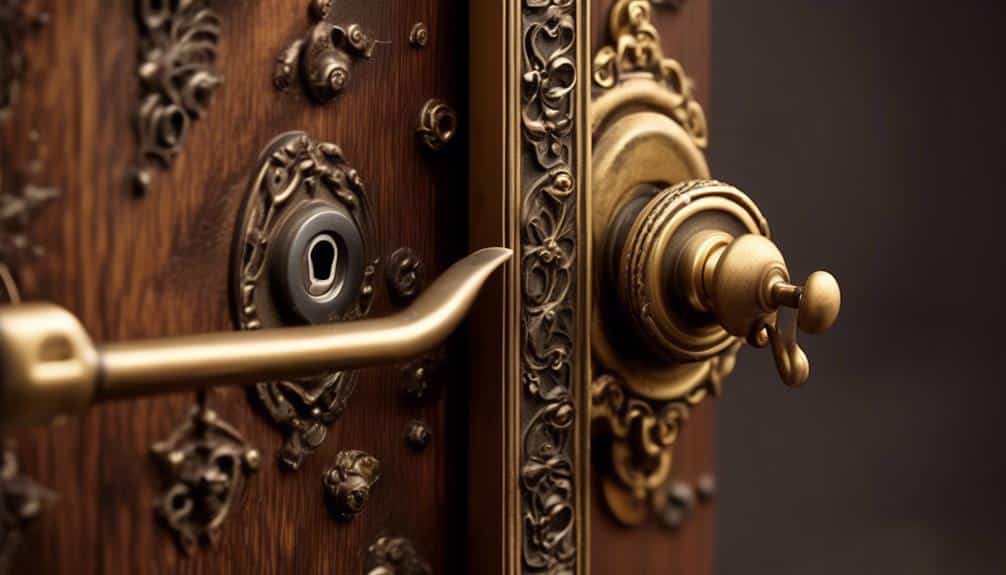
When duplicating keys for vintage lever handle locks, it's essential to employ specialized techniques and equipment to ensure accuracy and precision. Vintage lock restoration requires a deep understanding of the unique characteristics and intricacies of these old locks. Here are some key duplication techniques specifically tailored for vintage lever handle locks:
- Analysis of Lock Mechanism: Before attempting key duplication, it's crucial to thoroughly examine the lock mechanism to understand its design and operation. This analysis helps identify any wear or damage that may affect the accuracy of the duplication process.
- Precise Measurements: Vintage lever handle locks often have irregular key shapes and intricate bitting patterns. Taking precise measurements of the original key and its corresponding lock pins is vital to creating an accurate duplicate.
- Specialized Key Cutting Machines: Traditional key cutting machines may not be suitable for vintage lever handle locks. Utilizing specialized key cutting machines designed for these types of locks ensures precise duplication and minimizes the risk of damaging the original key or lock.
- Skillful Hand Filing: In some cases, hand filing is necessary to replicate the unique shape and contours of vintage lever handle keys. Skilled locksmiths with expertise in key duplication can accurately hand file keys to match the original.
- Quality Control and Testing: After duplicating the key, it's crucial to perform quality control checks and testing. This ensures that the duplicate key works smoothly in the vintage lever handle lock without any hitches or jams.
Mastering these key duplication techniques is essential for locksmiths involved in vintage lock restoration. By employing these specialized techniques and equipment, locksmiths can ensure that the duplicate keys they create for vintage lever handle locks are accurate and reliable.
Key Duplication for Master Key Systems
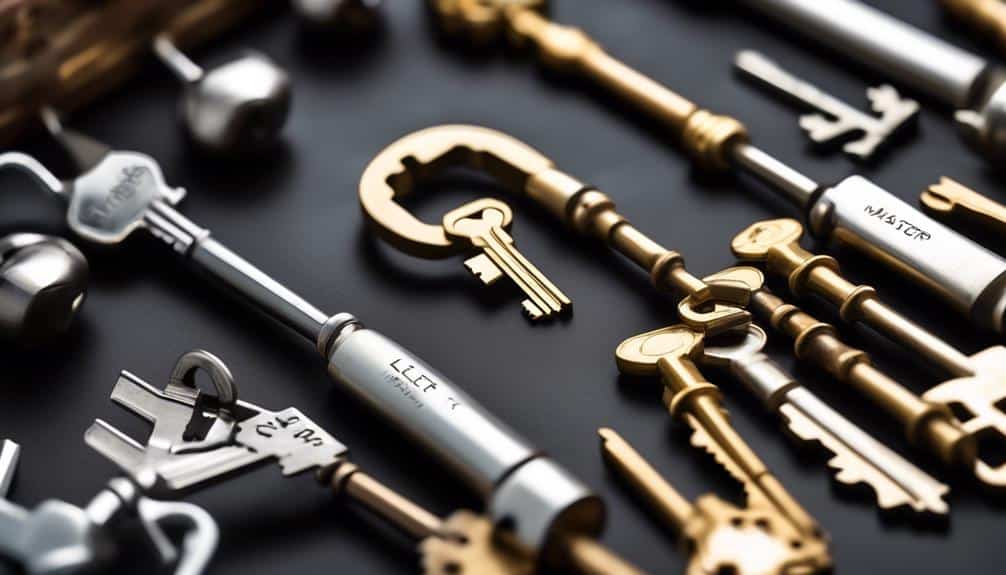
To ensure the accurate duplication of keys for master key systems, locksmiths must employ specialized techniques and equipment that cater specifically to the intricate nature of these complex locking systems. Master key systems provide numerous benefits, such as enhanced security, convenience, and control over access to different areas within a building. Key duplication for master key systems requires a thorough understanding of the system's design and functionality.
One key duplication technique for master key systems is the use of key cutting machines that are specifically designed for these complex locks. These machines utilize advanced technology to ensure precise and accurate duplication of master keys. Locksmiths must also have access to a wide range of key blanks that are compatible with various types of master key systems.
Another important technique in key duplication for master key systems involves proper key measurement and decoding. Locksmiths must carefully measure the key dimensions and decode its bitting codes to ensure accurate duplication. This process requires precision and attention to detail to avoid any errors that may compromise the functionality of the duplicated key.
Furthermore, locksmiths must possess extensive knowledge of different master key systems and their specific requirements. This expertise enables them to identify the appropriate key duplication techniques and equipment for each system. By staying updated with the latest advancements in key duplication technology, locksmiths can ensure the highest level of accuracy and efficiency when duplicating keys for master key systems.
Key Duplication for Restricted Key Systems
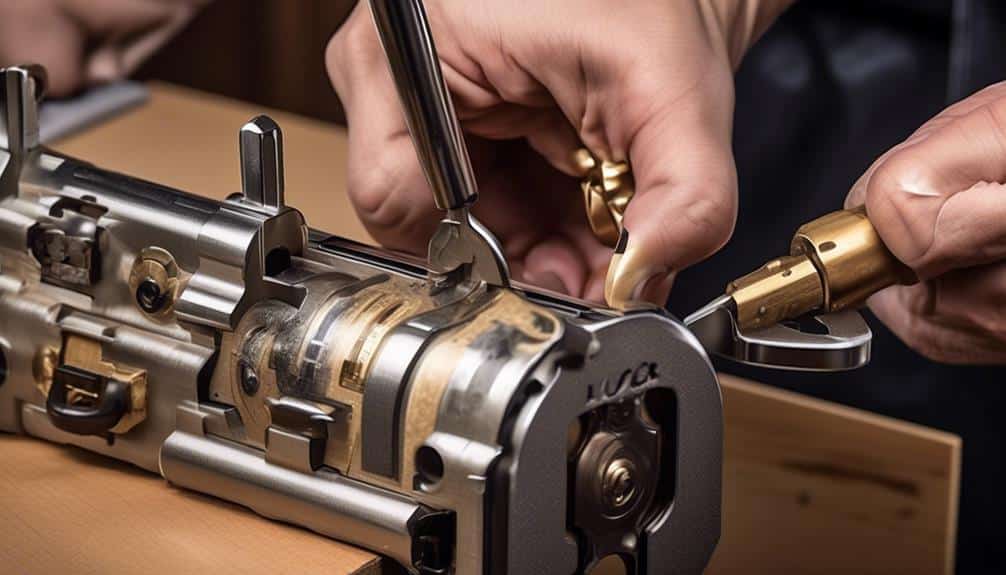
With a comprehensive understanding of master key systems and their specific requirements, locksmiths can now explore the intricacies of key duplication for restricted key systems. Restricted key systems offer numerous benefits and key control measures that enhance security and prevent unauthorized key duplication. Here are some key points to consider:
- Enhanced Security: Restricted key systems use unique key profiles that can't be duplicated without proper authorization. This ensures that only authorized individuals have access to the premises, reducing the risk of unauthorized entry.
- Key Control: Restricted key systems provide better control over key distribution and usage. Each key is marked and registered, allowing for easy tracking and identification of key holders.
- Reduced Risk of Unauthorized Duplication: Restricted key systems employ patented key blanks and specialized key cutting equipment. This makes it extremely difficult for unauthorized individuals to duplicate keys without the necessary authorization.
- Customizable Access Levels: Restricted key systems allow for the creation of different access levels within a facility. This means that certain keys can be restricted to specific areas or time frames, providing an added layer of security.
- Expertise and Professionalism: Key duplication for restricted key systems requires specialized knowledge and equipment. Locksmiths with expertise in this area can ensure that key duplication is done accurately and securely.
Tips for Finding a Reliable Locksmith for Key Duplication
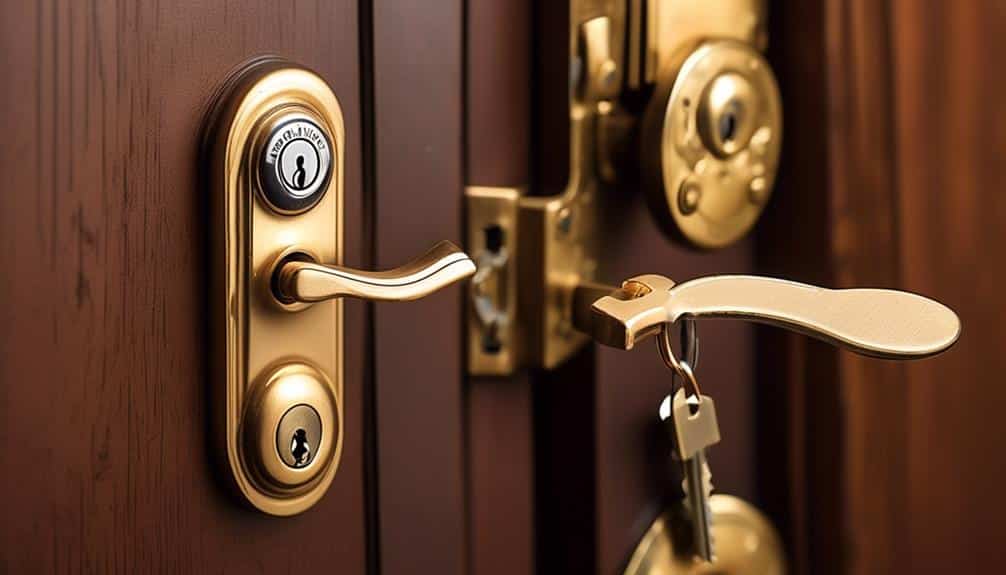
Finding a reliable locksmith for key duplication is crucial to ensure the accuracy and security of the process. When it comes to duplicating keys, it is important to find reputable locksmiths who have the necessary skills and experience. Here are some tips for finding a reliable locksmith and cost-effective key duplication options:
| Tip | Description |
|---|---|
| Ask for recommendations | Seek recommendations from trusted friends, family, or colleagues who have had positive experiences with locksmiths. |
| Research online reviews | Check online platforms such as Google, Yelp, or Angie's List for reviews and ratings of locksmiths in your area. |
| Verify credentials and licenses | Ensure that the locksmith you choose is licensed, bonded, and insured. This ensures that they have met the necessary requirements and can provide quality service. |
| Request a cost estimate | Before hiring a locksmith, ask for a detailed cost estimate that includes all fees and charges associated with the key duplication process. |
| Inquire about warranty and guarantees | Find out if the locksmith offers any warranty or guarantees on their work. This provides added peace of mind and ensures that any issues will be promptly resolved. |
| Compare prices and services | Obtain quotes from multiple locksmiths and compare their prices and services. This allows you to find the most cost-effective option without compromising on quality. |
Frequently Asked Questions
Can Lever Handle Locks Be Easily Duplicated Using a Standard Key Duplication Machine?
Well folks, when it comes to duplicating lever handle locks using a standard key duplication machine, things aren't as straightforward as they may seem.
Key duplication methods for lever handle locks in high security settings require specialized equipment and techniques.
The impact of key duplication on the overall security of lever handle locks can't be underestimated.
Therefore, it's important to consider the potential vulnerabilities and take appropriate measures to ensure the utmost security.
Are All Lever Handle Lock Key Blanks the Same Size and Shape?
Lever handle lock key blanks can vary in size and shape, making key duplication for these locks more challenging. The compatibility of lever handle lock keys depends on the specific lock manufacturer and model. It's crucial to have the correct key blank that matches the lock's design.
This level of specificity can pose difficulties in duplicating keys for lever handle locks using a standard key duplication machine. Precise knowledge and expertise are required to ensure accurate duplication.
Are Lever Handle Locks More Difficult to Duplicate Compared to Other Types of Locks?
Lever handle locks can be quite challenging to duplicate compared to other types of locks. The intricate lever handle lock key duplication techniques require precision and specialized knowledge.
These locks have unique security features that make them more resistant to unauthorized key duplication. The complexity lies in the specific shape and size of the key blanks, which differ from standard pin tumbler locks.
This adds an extra layer of difficulty, making lever handle lock key duplication a technical endeavor.
Can Lever Handle Locks With a Master Key System Be Duplicated Without Affecting the Master Key Functionality?
When it comes to lever handle locks with a master key system, duplicating them without affecting the master key functionality can be a complex task. Various duplication methods need to be considered to ensure the security concerns are addressed.
It's crucial to have a deep understanding of the lock's design and mechanisms to avoid compromising the master key system. By employing precise techniques and adhering to strict security protocols, it's possible to duplicate lever handle locks without compromising their master key functionality.
Are There Any Legal Restrictions on Duplicating Keys for Lever Handle Locks?
Yes, there are legal restrictions on duplicating keys for lever handle locks. The legality of key duplication varies depending on the type of lock.
For high security lever handle locks, the process of duplicating keys is more complex and requires specialized knowledge and equipment. It's crucial to adhere to the legal guidelines to ensure the security of the lock system.
Proper understanding of the regulations surrounding key duplication is essential to maintain the integrity of the master key functionality.

